
Good pest management practices use preventative, cultural, biological, and non-chemical methods whenever possible. However, there are times when these methods may not be effective on their own and a pesticide may need to be considered. In these cases, the use of the least toxic option is the best practice.
While any pesticide may be toxic to some extent the following suggestions will pose the lowest risk to humans, animals, beneficial insects and the environment. Some are pest-specific (such a Bacillus thuringiensis) and do no harm to other organisms, break down easily in the environment and therefore have little residual toxicity, or are contained in bait stations where human exposure is limited. Some ‘organic’ treatments may be less damaging to the environment than conventional insecticides but they are still listed as pesticides and should be evaluated before selection for their level of toxicity, environmental impact, effectiveness, and cost. The repeated application of an organic product may end up costing more and affecting other populations more than a single dose of a conventional product.
The following is the order of presentation of insecticides in this fact sheet:
- Horticultural Oils and Insecticidal Soaps
- Botanicals: Capsaicin, Essential Oils, Garlic, Limonene, Neem, Pyrethrin
- Insect Growth Regulators
- Microbials: Bacillus Thuringiensis, Baculoviruses, Beauveria Bassiana, Beneficial Nematodes, Milky Spore, Spinosad
- Minerals: Boric Acid, Diatomaceous Earth, Kaolin Clay, Silica Gel, Sulfur
Horticultural Oils and Insecticidal Soaps
Horticultural oils (including summer, superior, and dormant) and insecticidal soaps can be a valuable tool to manage a wide variety of insect and mite pests (including aphids, mealybugs, thrips, whiteflies, and scale) on fruits, berries, vegetables, roses, flowering shrubs, ornamentals, and houseplants. Pests do not generally develop resistance to hort oils or soaps. Horticultural oils can also be used against powdery mildew whose fungal strands or hyphae grow on the surface of plant leaves on susceptible plants. They both control many targeted pests with fewer potential adverse effects to the user as they are virtually non-toxic to humans. Both are very toxic to pollinators and therefore should not be used on plants that are in bloom unless used early morning, late evening, or when the plant is dormant. Pollinators are not affected by hort oils or insecticidal soaps once the product has dried. To be most effective, it's important to understand how horticultural oils and insecticidal soaps work, to know their mode of action, and to recognize their benefits and limitations.
Horticultural oils work on contact by suffocation when the spray forms a coating of oil on the insect's body, blocking the spiracles or breathing opening. Horticultural oils and insecticidal soaps also may interact with insect fatty acids disrupting cell membranes and metabolism causing dehydration. They have repellent properties acting as an antifeedant (discouraging feeding) for the euonymus webworm and some leaf rollers. As hort oils and soaps work on contact it is important that full coverage of upper and lower leaf surfaces takes place.
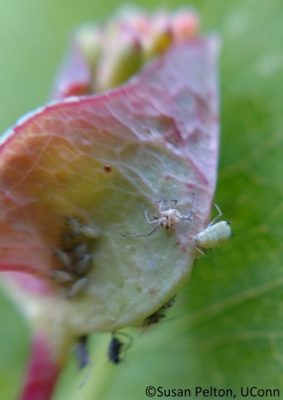
More than one application may be necessary as new populations appear. Hort oils and soaps can cause phytotoxicity (browning or burning of leaves) and should not be applied when temperatures are above 90°F, in full sun, if plants are drought-stressed, or when high humidity prevents leaf surfaces from drying rapidly. Apply oils (2% or up to 5 tablespoons of concentrate to a gallon of water) and soaps (1% or 2 ½ tablespoons to a gallon of water) in the early morning or evening. Only commercially prepared insecticidal soaps should be used as household soaps contain chemicals likely to cause foliage burn. Dormant oils are heavier, less-refined oils that are meant to be used on leafless, dormant plants to control overwintering insects. Hort oils mixed at a higher concentration (4% or 10 tablespoons of concentrate to a gallon of water) may be used as a dormant oil spray.
Botanicals
Botanical insecticides are naturally occurring toxins extracted from plants. There are several advantages to using botanical rather than synthetic insecticides. Plant derived insecticides breakdown quickly in the environment, resulting in negligible risk of residues on food crops and less risk to beneficial insects. Some materials can be used shortly before harvest. Most botanicals are rapid acting and most, but not all botanicals, are of low to moderate toxicity to mammals. Because most botanical insecticides must be eaten by the insect pest, they are primarily harmful to these pests and do little harm to beneficial insects.
Botanicals, while less risky to health and environment, break down quickly in the environment which often creates a need for precise timing and/or more frequent applications. Several botanical insecticides such as Rotenone, Sabadilla, Ryania, and Nicotine are quite toxic and can be difficult to find in local stores or are no longer available commercially.
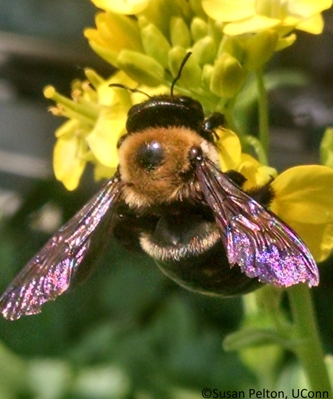
Capsaicin
Capsaicin is the natural chemical that makes chili peppers hot and is primarily used as an insect repellent. It can control aphids, spider mites, thrips, whitefly, lace bugs, leafhoppers, and other pests by damaging cell membranes and disrupting the nervous system. It can also repel animal pests such as rabbits, deer, and squirrels. Birds are not affected by capsaicin but it is toxic to bees and other beneficial insects.
Essential Oils
Essential oils are non-water-soluble liquids that contain volatile aroma compounds from plants. As of 1996 the EPA no longer requires its approval for these ingredients to marketed as insecticides as they pose minimal risk to users. Among these essential oils are oils of cedar, cinnamon, citronella, citrus (Limonene), clove (and its component eugenol), eucalyptus, garlic, lavender, mints, rosemary, sesame, and thyme. Pennyroyal is the exception as it contains pulegone, a potent toxin that is fatal to humans in a dose a small as one tablespoon when ingested.
Essential oils are used as neuro-disrupters, repellents and in some cases, anti-fungal but they volatilize quickly so that repeated applications may be necessary. Essential oils biodegrade easily and do not persist in soil and water but they are less refined than horticultural oils and may cause phytotoxicity to plant foliage.
The active component of clove oil, eugenol, is a fast acting contact insecticide that is effective on a wide variety of household pests such as ants, cockroaches, crickets, dust mites, fleas, flies, spiders, and wasps. It is also used on some ornamental plant pests such as aphids, armyworms, mites, and thrips. Eugenol has little or no residual activity other than a lingering scent of cloves. Products based on eugenol are considered minimum risk pesticides with very low risk of damage to the environment but eugenol is rapidly absorbed by skin and is toxic to human skin cells. It can cause severe eye irritation so applicators should wear protective eye wear and waterproof gloves when handling and spraying. Often clove oils are mixed with other natural oils, such as rosemary oil, thyme oil, and sesame oil for enhanced control.
Garlic
Garlic is marketed in several products intended to repel insects, much as capsaicin does, or as a suppressant for powdery mildew and some fungi. Products are labeled to repel a wide variety of pests on ornamental plants, but garlic may also repel nuisance animals. To date there is limited research showing effectiveness of garlic insecticides. It is non-toxic to pollinators.
Limonene
Limonene is produced from citrus oils that are extracted from oranges and other citrus fruit peels and is named for its characteristic odor. It is a repellent that is used to control the external pests of animals in products such as flea and tick shampoos and as a contact insecticide against ants, roaches, palmetto bugs, silverfish and other insects, and mosquito larvicides. Limonene is thought to create a massive overstimulation of the central nervous system creating paralysis although a secondary synergist is needed to create a toxic reaction. Limonene has a low oral and dermal toxicity to mammals, birds, and fish although it can cause skin irritation to some people. It is of low toxicity to pollinators.
Neem Oil
Neem oil is made from the extract of the Neem tree (Azadirachta indica) seed and Azadirachtin is the active ingredient. It can control a wide variety of insects including aphids, beetles, caterpillars, leafminer, mealybugs, sawfly larvae, scale, spider mites, thrips, and whiteflies. Neem oil is effective against actively growing immature insects, stopping their feeding and disrupting their molting process so that they do not mature into adults. It may also suffocate soft-bodied insects by blocking the breathing openings. Mating and sexual communication is disrupted in adults and egg-laying is deterred. Neem oil also has some fungicidal properties that control powdery mildew but not as efficiently as a horticultural oil.
Commercial neem products are labeled for use on ornamentals, foliage plants, trees, shrubs, and food crops as it breaks down in 1-2.5 days. It can act as a repellent to nematodes. The active ingredient in neem oil, Azadirachtin, has a very low toxicity to humans and animals although it is slightly toxic to fish and aquatic animals. It is of low toxicity to pollinators.
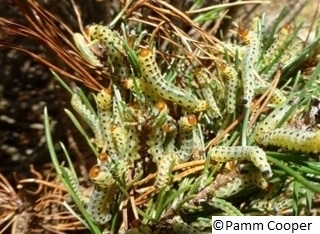
Pyrethrin
Pyrethrin pesticides are derived from the flower Chrysanthemum cinerariifolium that work by targeting the nervous systems of insects. Pyrethrum is the crude flower dust and pyrethrin refers to the insecticidal compound extracts. Pyrethroids are the synthetically produced pesticides that constitute the majority of commercially produced insecticides.
Pyrethrin is a contact insecticide that rapidly paralyzes the nervous system of both target and nontarget insects. This does not kill the insect and the pyrethrin can be detoxified by enzymes in the insect. Therefore, a second compound is needed, generally an organophosphate, carbamate, or synergist, to create a lethal dose. Bees are extremely sensitive to the effects of pyrethrin therefore pyrethrins should be applied at night to avoid the time when pollinators are visiting plants. Also, a liquid spray formula should be used in lieu of a dust.
The combination of the facts that mammalian toxicity is very low with pyrethrins and that it breaks down within a few hours mean that it may be sprayed on food crops close to harvest. However, fish mayflies, gadflies and other lower level invertebrates of the aquatic food chain lack the enzymes to break down pyrethrins and pyrethroids leading to a toxic buildup. It can pass unaffected through secondary treatment levels of municipal wastewater treatment facilities so leftover solutions containing pyrethrins should not be poured down drains.
Insect Growth Regulators
Insect growth regulators are chemicals used as insecticides that inhibit the life cycle of an insect and are generally used to control populations of cockroaches and fleas. IGRs are labeled as ‘reduced risk’ by the EPA as they target the juvenile pest insect but do not harm beneficials. IGRs prevent an immature insect from reaching maturity because it interferes with its molting process, sometimes tricking the immature insect into pupating too early. They can also affect egg development. IGRs are safe for humans and animals making them an appropriate choice when an insecticide is needed in the home.
Microbials
Microbial insecticides control insect pests with living microorganisms such as bacteria, fungi, protozoa, and viruses that can be applied as dusts, granules, or sprays. Nematodes are often included in this category due to their microscopic size although they are technically not a microbial agent. Most microbial insecticides are very host-specific. This is important when protecting beneficial insects from unwanted consequences.
Bacillus Thuringiensis
Bacillus thuringiensis, or Bt, is a widely used microbial biological insect control. Bt is a bacterium that produces crystal proteins that poison, paralyze, and kill targeted pests after ingestion. Bt is found in soil all over the world in almost all types of terrain from desert to tundra.
Bt bacteria are one-celled organisms that reproduce asexually through spores creating crystal proteins as it does. These spores and crystals must be ingested by the immature feeding stage of development (larval) of insects to be effective so it is important to spray all plant parts that will be consumed including both upper and lower leaf surfaces. Treatment should be done on a cloudy day or in the evening as Bt breaks down rapidly in sunlight. Most Bt formulations are ineffective against mature insects except for Bt galleriae and are not harmful to animals, birds, humans, or pollinators. Once inside the digestive gut the crystals dissolve causing a paralysis that interrupts normal digestion and causes the larvae to stop feeding. Bt spores continue to multiply within the dying insect and will return to the soil as the insect decomposes.
Particular strains of Bt proteins are host-specific, binding to certain receptors in the insect's gut wall like a lock and key. It is important to use the strain of Bt that targets a certain pest. New to the home market in 2015 was the strain Bacillus thuringiensis galleriae (Btg) which is reportedly effective against both the adult and grub forms of Japanese, Asian, and Oriental beetles, all of which cause large amounts of damage to turf.
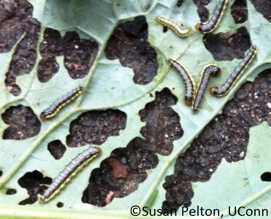
The following are some of the most commonly used Bt strains:
| Strain | Order Affected | Uses |
| Bt aizawai | Lepidoptera: Moths, Butterflies |
Wax moth larvae in honeycombs, grape berry moth |
| Bt galleriae (Btg) | Coleoptera: Beetles | Possibly both adult and larval stages of Asian, Japanese, and Oriental beetles |
| Bt israelensis | Diptera: Flies, Mosquitos, Gnats |
Mosquito larvae, fungus gnat larvae, blackfly larvae |
| Bt japonensis and kumamotonsis | Coleoptera: Beetles | Northern masked chafer and oriental beetle larvae |
| Bt kurstaki (BtK) | Lepidoptera: Moths, Butterflies |
Cabbage loopers, codling moth larvae, diamondback moth larvae, imported cabbageworm, spruce budworms, tomato hornworms, cutworm, Gypsy moth caterpillars (prior to June 1st when GM larvae are small) |
| Bt var. san diego (BtSD) and tenebrionis |
Coleoptera: Beetles | Leaf-feeding beetle larvae, black vine weevil larvae, boll weevil larvae, Colorado potato beetle larvae, Elm leaf beetle larvae |
Baculovirus
Baculovirus (Baculoviridae) are pathogens that control insects and arthropods by causing disease outbreaks among populations. Insect baculoviruses must be eaten by the host to produce the typically fatal infection. Baculovirus are not toxic to humans, animals, birds, fish, and nontarget insects. Development has been limited in this field but one of the current uses by the USDA Forest Service is the gypsy moth nuclear polyhedrosis virus (LdNPV) as a control for the Gypsy moth larvae. Control viruses are also in use against the beet armyworm, tobacco budworm, and cotton bollworm.
For example, Gypsy moth caterpillars than have been infected with the LdNPV can be seen hanging limply from vegetation in an inverted V. When the infected insect ruptures it releases a fluid filled with infected virus particles. The virus is spread as target insects eat the contaminated foliage.
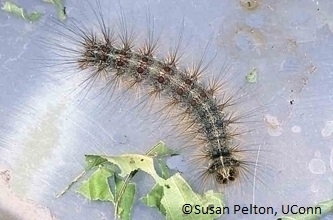
Beauveria Bassiana
Beauveria bassiana is a natural, soil-borne entomopathogenic (parasitic) fungus that attacks and kills a variety of immature and adult insect pests including aphids, bark beetles, boll weevils, chinch bugs, Colorado potato beetles, codling moths, cutworms, European corn borers, fire ants, grasshoppers, Japanese beetles, leafhoppers, Mexican bean beetles, sod webworms, termites, and whiteflies. It also attacks beneficial insects such as Asian lady beetles and may be of use in the control of bed bugs and malaria-transmitting mosquitos.
Beauveria takes 3-7 days after application for the spores to germinate on the surface of the insect, penetrate, and grow inside an insect before killing them so it is best applied at the onset of an infestation. Fungal spores must contact the insect for infection to occur so thorough spray coverage is necessary.
Beauveria bassiana is nontoxic to humans or animals(except fish) but certain strains will target beneficial insects such as pollinators as well as pest insects.
Beneficial Nematodes
Beneficial nematodes are microscopic, worm-like parasites some of which are pests of turf grass and other plants, others which are beneficial. Beneficial nematodes are a parasitic control of harmful insects that are particularly effective in cases where insecticide resistance has developed. These naturally occurring organisms are microscopic, unsegmented roundworms that live in the soil and, depending on the species, infect plants and animals. The two nematode families Steinernematidae and Heterorhabditidae, contain the insect parasitic nematode species. The most commonly used beneficial nematodes are Steinernema carpocapsae, S. feltiae, S. glaseri, Heterorhabditis heliothis and H. bacteriophora.
Select nematode species will control a wide variety of agricultural pests including the larvae of black vine weevil, clearwing borers, cutworms, mole crickets, sod webworms, and white grubs. Nematodes will kill their host within 48 hours.
Nematodes must be shipped, stored, and used under specific temperature and moisture conditions for optimum performance. They should be ordered as soon as a problem is noticed. It is crucial to apply them at the optimum environmental conditions needed for their survival. Therefore, it is best to irrigate the target site, both before and after application, because they need moist conditions to prevent desiccation and aid with movement to find hosts. Also, the best results are obtained when the relative humidity is high, ambient temperature is neither extremely hot or cold, soil temperature is between 55º and 90ºF, soil is moist and direct sunlight is minimal. These factors help prevent the nematodes from drying out and increase their survival.
Milky Spore
Milky spore is a bacterial disease caused by Paenibacillus popilliae (formerly Bacillus popilliae) and Bacillus lentimorbus that is used as a control for the grubs of the Japanese beetle (P. popilliae) and scarab beetle larvae (B. lentimorbus). When these grubs are feeding close to the surface in August they are most vulnerable to infestation by this disease and so this is the best time for soil inoculation. The grubs ingest spores in the soil as they feed on plant roots (specifically turf). The bacteria reproduce in the grubs guts and will cause death in 7-10 days. As the dead grubs decompose billions of new spores are released into the soil. Milky spore can survive drought conditions but it does not do well in Zone 5 and colder and may be unsuitable for northern areas of Connecticut. Soil temperatures (not air) need to be at 66-70℉ for reproduction to occur. Milky spore is not harmful to humans, animals, birds, bees, and other beneficial insects.
Spinosad
Spinosad is an insecticide that is based on chemical compounds found in the bacterial species Saccharopolyspora spinosa that works both by contact and by ingestion to control a variety of insects including ants, beetles, borers, fruit flies, leafminer, mosquitoes, spider mites, and thrips. Spinosad works by affecting the nervous system, causing muscles to flex uncontrollably leading to paralysis and then death. While wet, spinosad is toxic to bees and should not be applied to plants in flower. Apply spinosad in the evening when it will have time to dry before pollinators visit. Spinosad is not toxic to humans, animals, birds, and is slightly toxic to fish and aquatic invertebrates. Products containing spinosad may be sold as sprays or in a granular form in ant baits.
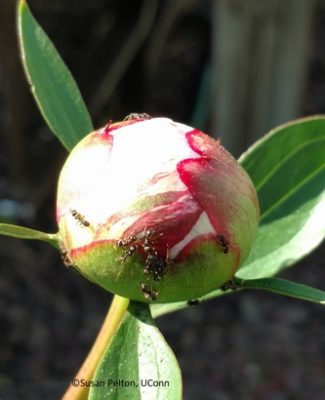
Minerals
Boric Acid
Boric acid is a naturally occurring mineral that when ingested acts as a stomach poison to control many insect pests including cockroaches, fire ants, fleas, silverfish, and termites. In a powdered form it is abrasive to insects exoskeletons. Boric acid should not be applied around plants even though boron is a trace element that is necessary to plants, in little more than trace amounts it is toxic to plants. It is not toxic to humans and animals unless it is ingested, it is non-toxic to birds, minimally toxic to fish and bees.
Boric acid may be found in preloaded bait stations making it a very safe choice for use in a home environment.
Diatomaceous Earth
Diatomaceous earth is a non-toxic powder made from the fossilized remains of tiny aquatic organisms called diatoms. Their skeletons are composed of silica and are used as a dust to control ants, aphids, bed bugs, cockroaches, crickets, fleas, millipedes, spiders, sow bugs, and slugs. Diatomaceous earth is not a poison, it works as a desiccant, causing insects to dry out. The sharp abrasive edges can cut into the insect, speeding up the process. It is not toxic to humans, animals, fish, or birds although prolonged exposure may irritate lungs and other tissues. It is highly toxic to bees.
Kaolin Clay
Kaolin clay is a soft, earthy, usually white mineral that is mixed with water into a slurry that is then sprayed on fruits, vegetables, and foliage. The whitish-gray particulate film acts as a barrier and prevents insects from recognizing and subsequently feeding on the treated plants. It cannot control a pest that is already established. Kaolin can be used to control Colorado potato beetles, cucumber beetles, Japanese beetles, leafhoppers, tarnished plant bugs, and thrips. Kaolin is non-toxic to humans, animals, and pollinators and can be applied up to the day of harvest.

Silica Gel
Silica gel is a naturally occurring mineral that absorbs moisture. When silica gel encounters the waxy coating on an insect’s body it causes death by dehydration. Silica gel products are used to control bed bugs, cockroaches, silverfish, and other pests.
Sulfur
Sulfur is an element that can be found in food, plants, soil, and water. As a fungicide and an insecticide, it is probably one of the oldest known pesticides in use. Sulfur kills fungi on contact and insects if they either eat or touch it. Sulfur destroys an insect’s normal energy-producing bodily function. It is available in many forms: dust, wettable powder, paste, or liquid. Mites, psyllids, and thrips are controlled by sulfur but it has some caveats. Sulfur can damage plants during hot (over 80℉), dry weather and it is incompatible with some other pesticides. Sulfur should not be used on plants that have been sprayed with horticultural oils as the reaction can damage foliage. It is non-toxic to humans and animals unless ingested. It has low level toxicity to bees.
Pesticide Safety Tips
Always read the pesticide label and follow its directions exactly. You may only use the pesticide on sites or crops listed on the label. Be sure to observe all special precautions that are listed on the label. Wear protective clothing or equipment as listed on the label when mixing or applying pesticides. Mix pesticides at the rate recommended for the target site as listed on the label. Never use more than the label says. Follow all label directions for safe pesticide storage and disposal. Always remember to read and heed the six most important words on the label: "KEEP OUT OF REACH OF CHILDREN."
Avoid the use of spray pesticides (both insecticides and fungicides), as well as soil-applied, systemic insecticides unless necessary to protect beneficial insects. If spraying is necessary, spray late in the evening to reduce the direct impact on pollinating insects. Try less toxic alternative sprays first for the control of insect pests and diseases. Practice cultural techniques to prevent or reduce the incidence of plant diseases, including pre-plant soil improvement, proper plant spacing, crop rotation, applying mulch, applying lime and fertilizer based on soil test results, and avoiding over-head irrigation and frequent watering of established plants.
Despite good cultural practices, pests and diseases at times may appear. Chemical control should be used only after all other methods have failed. For pesticide information please call UConn Home and Garden Education Center weekdays toll free at 860-486-6271.
UConn Home and Garden Education Center, 2017